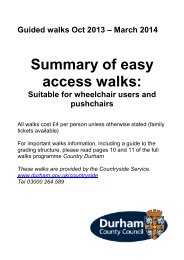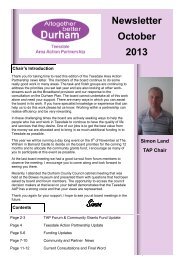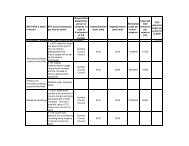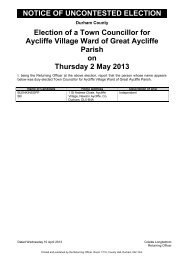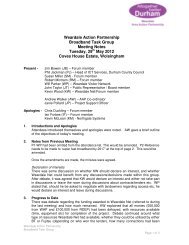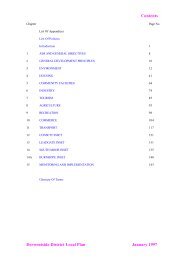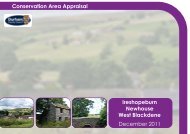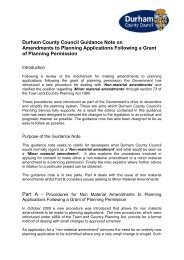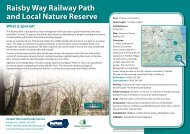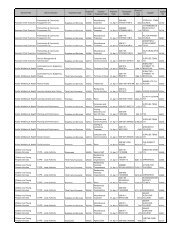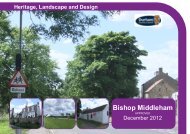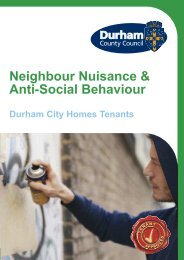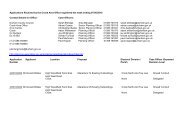SECTION 3.0 - Durham County Council
SECTION 3.0 - Durham County Council
SECTION 3.0 - Durham County Council
You also want an ePaper? Increase the reach of your titles
YUMPU automatically turns print PDFs into web optimized ePapers that Google loves.
Biodiversity Action Plan Species and Habitats:<br />
In order to maintain and enhance biodiversity, it is important that the relevant<br />
species and habitat targets are adopted from the Local Biodiversity Action Plan<br />
(LBAP).<br />
PPS9 states that LDF’s should: ‘identify any areas or sites for the restoration<br />
or creation of new priority habitats<br />
which contribute to regional targets, and<br />
support<br />
this restoration or creation through appropriate policies.’<br />
Published<br />
in 1999, the first <strong>Durham</strong> Biodiversity Action Plan (DBAP), "Action for<br />
Wildlife"<br />
included a number of action plans to conserve and enhance identified<br />
priority habitats and species. The <strong>Durham</strong> BAP was prepared by the <strong>Durham</strong><br />
Biodiversity Action Plan Partnership (DBAPP)<br />
d individuals. A full list of the priority habitats,<br />
pecies and associated action plans are in Appendix 5. The DBAP<br />
15 . The revised <strong>Durham</strong> BAP was<br />
launched in July 2007. It sets the agenda for wildlife conservation across the<br />
<strong>County</strong> for all organisations an<br />
s will be<br />
periodically updated on their website. Protocols<br />
for data collation, validation and<br />
management for the <strong>Durham</strong> BAP are currently being established. The DBAP will<br />
focus their<br />
work between September 2007 and March 2008 on creating the basis<br />
of a biodiversity data service to local authority<br />
and other partners and consultants.<br />
Biodiversity Action Reporting System (BARS) is an information system that<br />
supports the planning, monitoring and reporting requirements of national, local and<br />
company BAPs. It enables progress being made with local and<br />
national BAPs and<br />
the status<br />
of BAP species and habitats to be monitored.<br />
The Regional Spatial Strategy contains<br />
a number of objectives related to<br />
conserving, enhancing and capitalising upon the region’s diverse natural and built<br />
environment, heritage and culture including the establishment of "Biodiversity<br />
Target Zones" and "Habitat Creation<br />
and Enhancement Areas".<br />
Regionally there is also the Biodiversity Audit of the North<br />
East and Biodiversity<br />
Indicators and Targets of the North East of England.<br />
As per above, data coverage for priority species and habitats is patchy across the<br />
<strong>County</strong>. There is a need to carry out further survey work in order to ensure that a<br />
more conclusive picture of the location of priority habitats and species is produced.<br />
This will ensure that more sustainable<br />
and informed planning decisions can be<br />
made.<br />
List of UKBAP and DBAP species<br />
and habitats in appendices.<br />
• Mapping sensitive bird areas and flight paths project<br />
Aim of the project was to define and map<br />
areas, and plot likely flight routes,<br />
of particular importance for feeding and breeding bird species in order to<br />
minimise the impact of developments that might arise as a result of Borough<br />
<strong>Council</strong>’s Local Development Framework. The project was initiated following<br />
consultation on Sedgefield Borough’s Core Strategy and Appropriate<br />
15 In addition to <strong>County</strong> <strong>Durham</strong> the <strong>Durham</strong> BAP also covers Darlington, Gateshead, South<br />
Tyneside and Sunderland.<br />
Page 49 4/15/2009<br />
Link with Strategic<br />
Renewable<br />
Energy Technical<br />
Paper (No.14)



